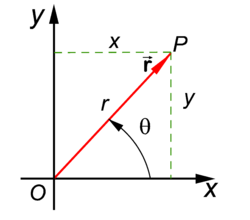Polar coordinates: Difference between revisions
Jump to navigation
Jump to search

imported>Paul Wormer No edit summary |
imported>Paul Wormer |
||
| Line 18: | Line 18: | ||
360^0 - \arccos(x/r) & \hbox{ if } y < 0 .\\ | 360^0 - \arccos(x/r) & \hbox{ if } y < 0 .\\ | ||
\end{cases} | \end{cases} | ||
</math> | |||
==Surface element== | |||
The infinitesimal surface element in polar coordinates is | |||
:<math> | |||
dA = J\, dr\,d\theta. | |||
</math> | |||
The [[Jacobian]] ''J'' is the determinant | |||
:<math> | |||
J= \frac{\partial(x,y)}{\partial(r,\theta)} = | |||
\begin{vmatrix} | |||
\cos\theta & -r\sin\theta \\ | |||
\sin\theta & r\cos\theta \\ | |||
\end{vmatrix} | |||
= r . | |||
</math> | |||
Example: the area ''A'' of a circle of radius ''R'' is given by | |||
:<math> | |||
A = \int_{0}^{2\pi} \int_{0}^R r\, dr\, d\theta = \pi R^2 | |||
</math> | </math> | ||
Revision as of 07:13, 23 January 2008
In mathematics and physics, polar coordinates give the position of a vector in two-dimensional real space . A Cartesian system of two orthogonal axes is presupposed. One number (r) gives the length of the vector and the other number (θ) gives the angle of the vector with the x-axis of the Cartesian system (measured in the direction of the positive y-axis).
Definition
The polar coordinates are related to the Cartesian coordinates x and y through
so that for r ≠ 0,
Surface element
The infinitesimal surface element in polar coordinates is
The Jacobian J is the determinant
Example: the area A of a circle of radius R is given by







